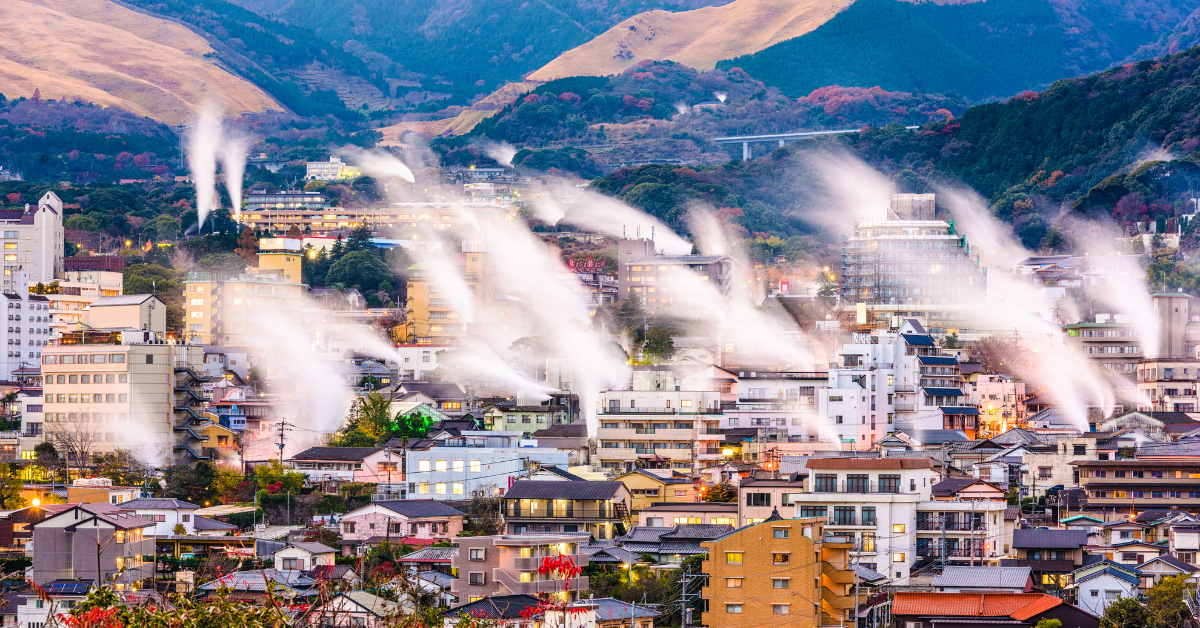Beppu, located in Oita Prefecture, is one of Japan’s most famous hot spring resorts. It is renowned for having the largest number of hot springs and the highest output in the country. Japanese people regard Beppu not only as a tourist destination but also as a cultural symbol deeply connected to everyday life. For foreign visitors, understanding this reputation adds greater meaning to the experience of soaking in Beppu’s diverse baths.
The Appeal of Beppu for Japanese People
Recognition as a Symbol of Onsen Culture
For Japanese people, hot springs are an extension of daily life and a place of relaxation, and Beppu stands as a prime example. Its vast number of sources and diverse spring qualities are the reason it is called “Japan’s number one hot spring resort.” Attractions such as the famous “Jigoku Meguri” (Hell Tour), sand baths, and steam baths are enjoyed not only by tourists but also by locals, making Beppu a cultural icon.
| Feature | Description |
|---|---|
| Rich hot springs | More than 2,000 sources |
| Diverse qualities | Sulfur, carbonated, chloride, and more |
| Tourist attractions | Jigoku Meguri, sand baths, steam baths |
Affordability and Accessibility
Despite being a renowned tourist destination, Beppu offers a wide price range, making it accessible for students, families, and travelers of all kinds. Alongside large tourist facilities, many communal baths are frequented by locals, reflecting Beppu’s role as a hot spring culture rooted in everyday life.
| Visitor Type | Reason for Favorability |
|---|---|
| Students | Affordable lodging and entry fees |
| Families | Many facilities are family-friendly |
| Locals | Easy access as part of daily routines |
Convenience of Beppu for Japanese Visitors
Accessibility
With easy access from Oita Airport and other parts of Kyushu by train and bus, Beppu is highly convenient. Japanese travelers often value ease of travel, and Beppu earns high marks in this regard.
A Combination of Tourism and Cuisine
Beppu is not only famous for hot springs but also for its rich food culture. Local specialties such as chicken tempura (toriten), seki-aji (horse mackerel), and seki-saba (mackerel) increase traveler satisfaction. The ability to enjoy both hot springs and food at once is a major attraction.
| Culinary Highlight | Description |
|---|---|
| Local specialties | Toriten, dango-jiru (dumpling soup) |
| Seafood | Seki-aji, seki-saba |
| Onsen cuisine | Jigoku-mushi (steamed dishes using hot spring steam) |
Challenges Noted by Japanese Tourists
Crowds and Over-commercialization
As a popular destination, Beppu can become overcrowded with tourists during holidays and peak seasons. For some who seek quiet relaxation, this is seen as a drawback, while others view the lively atmosphere as a form of vibrancy.
Aging Facilities
Traditional inns and long-established hot spring facilities offer charm and history, but some suffer from aging structures and outdated equipment. Since cleanliness and comfort are valued highly by Japanese visitors, this can be a source of dissatisfaction. However, some travelers appreciate the “nostalgia” of older buildings, adding to Beppu’s diversity.
Summary of Beppu’s Reputation Among Japanese People
| Aspect | Details |
|---|---|
| Positive | Variety of springs, largest number of sources, deeply rooted in daily life |
| Convenience | Excellent access, combination of food and hot springs |
| Challenges | Overcrowding, aging facilities |
Comparing Beppu with Other Hot Spring Resorts
Differences from Kusatsu and Hakone
Kusatsu is known for its strongly acidic waters with high medical efficacy but limited suitability depending on body type. Hakone, close to Tokyo and rich in sightseeing spots, is highly convenient but sometimes criticized for being too commercialized. Beppu, by contrast, offers both diverse spring qualities and down-to-earth communal baths, positioning it as a microcosm of hot spring culture.
| Resort | Features | Japanese Evaluation |
|---|---|---|
| Kusatsu | Strongly acidic waters, therapeutic | Popular among those seeking efficacy |
| Hakone | Close to Tokyo, tourist facilities | Popular for accessibility |
| Beppu | Diverse springs, community-based culture | Supported by a broad demographic |
Popular Experiences for Foreign Visitors
Jigoku Meguri and Experiential Hot Springs
Among foreign visitors, the most popular activity is the Jigoku Meguri (Hell Tour). The steam and boiling waters create an impressive spectacle, offering even Japanese travelers a sense of the extraordinary. Sand baths and steam baths are also highly favored for their unique way of warming the body, making them memorable cultural experiences.
Fusion with Food Culture
Equally appreciated is Beppu’s food culture. Visitors often relax in hot springs and then savor local cuisine, which enhances both physical and emotional satisfaction. The Japanese tradition of combining hot springs with dining is refreshing and captivating for foreign guests.
Conclusion
For Japanese people, Beppu is regarded as “a hot spring town woven into everyday life.” Its diverse spring qualities, wide affordability, and culinary richness earn consistent praise, while issues such as crowding and aging facilities remain as challenges. Even so, Beppu stands as a symbol of Japan’s hot spring culture. For foreign travelers, it provides not only sightseeing but also a chance to understand hot springs as a way of life in Japan. Beppu is a place of high value and well worth visiting.






